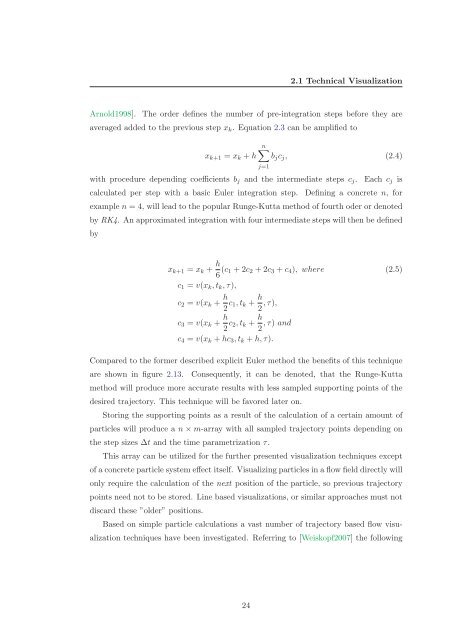Master's Thesis - Studierstube Augmented Reality Project - Graz ...
Master's Thesis - Studierstube Augmented Reality Project - Graz ...
Master's Thesis - Studierstube Augmented Reality Project - Graz ...
Create successful ePaper yourself
Turn your PDF publications into a flip-book with our unique Google optimized e-Paper software.
2.1 Technical Visualization<br />
Arnold1998]. The order defines the number of pre-integration steps before they are<br />
averaged added to the previous step x k . Equation 2.3 can be amplified to<br />
n∑<br />
x k+1 = x k + h b j c j , (2.4)<br />
with procedure depending coefficients b j and the intermediate steps c j . Each c j is<br />
calculated per step with a basic Euler integration step. Defining a concrete n, for<br />
example n = 4, will lead to the popular Runge-Kutta method of fourth oder or denoted<br />
by RK4. An approximated integration with four intermediate steps will then be defined<br />
by<br />
j=1<br />
x k+1 = x k + h 6 (c 1 + 2c 2 + 2c 3 + c 4 ), where (2.5)<br />
c 1 = v(x k , t k , τ),<br />
c 2 = v(x k + h 2 c 1, t k + h 2 , τ),<br />
c 3 = v(x k + h 2 c 2, t k + h , τ) and<br />
2<br />
c 4 = v(x k + hc 3 , t k + h, τ).<br />
Compared to the former described explicit Euler method the benefits of this technique<br />
are shown in figure 2.13.<br />
Consequently, it can be denoted, that the Runge-Kutta<br />
method will produce more accurate results with less sampled supporting points of the<br />
desired trajectory. This technique will be favored later on.<br />
Storing the supporting points as a result of the calculation of a certain amount of<br />
particles will produce a n × m-array with all sampled trajectory points depending on<br />
the step sizes ∆t and the time parametrization τ.<br />
This array can be utilized for the further presented visualization techniques except<br />
of a concrete particle system effect itself. Visualizing particles in a flow field directly will<br />
only require the calculation of the next position of the particle, so previous trajectory<br />
points need not to be stored. Line based visualizations, or similar approaches must not<br />
discard these ”older” positions.<br />
Based on simple particle calculations a vast number of trajectory based flow visualization<br />
techniques have been investigated. Referring to [Weiskopf2007] the following<br />
24





